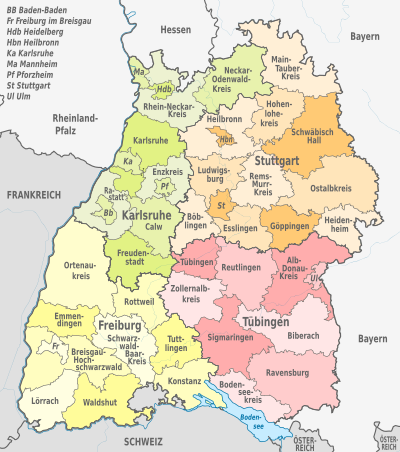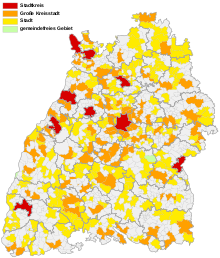Baden-Württemberg
![]()
This article is about the federal state. For the warship of the same name, see Baden-Württemberg (F 222).
Baden-Württemberg [![]()
![]() ˌbaːdn̩ˈvʏrtəmbɛrk] (abbreviation BW; officially Land Baden-Württemberg) is a parliamentary republic and a partially sovereign constituent state (Land) in the southwest of the Federal Republic of Germany. It was founded in 1952 by merging the short-lived post-war states of Württemberg-Baden, (South) Baden and Württemberg-Hohenzollern, and is thus in the tradition of the old states of Baden and Württemberg. In terms of both population and area, Baden-Württemberg ranks third among the German states. The most populous city in Baden-Württemberg is the state capital Stuttgart, followed by Mannheim and Karlsruhe. Other large cities are Freiburg im Breisgau, Heidelberg, Ulm, Heilbronn, Pforzheim and Reutlingen.
ˌbaːdn̩ˈvʏrtəmbɛrk] (abbreviation BW; officially Land Baden-Württemberg) is a parliamentary republic and a partially sovereign constituent state (Land) in the southwest of the Federal Republic of Germany. It was founded in 1952 by merging the short-lived post-war states of Württemberg-Baden, (South) Baden and Württemberg-Hohenzollern, and is thus in the tradition of the old states of Baden and Württemberg. In terms of both population and area, Baden-Württemberg ranks third among the German states. The most populous city in Baden-Württemberg is the state capital Stuttgart, followed by Mannheim and Karlsruhe. Other large cities are Freiburg im Breisgau, Heidelberg, Ulm, Heilbronn, Pforzheim and Reutlingen.
Baden-Württemberg is the German state with the highest exports (2019), the second-lowest unemployment rate (May 2021), the fourth-highest gross domestic product (GDP) per capita (2020), as well as the most patents registered per capita (2020) and the highest research and development expenditure in absolute and relative terms (2017). Average life expectancy in 2017/19 was 79.8 years for men and 84.2 years for women, ranking both first among German states.
Sovereign Symbols
→ Main article: Coat of arms of Baden-Württemberg and flag of Baden-Württemberg
The coat of arms shows three striding lions on a golden background. This is the coat of arms of the Staufers and Dukes of Swabia. Above the large state coat of arms are the six coats of arms of the historical landscapes from which or from whose parts Baden-Württemberg was formed. These are: Vorderösterreich (red-white-red divided shield), Kurpfalz (rising lion), Württemberg (three stags), Baden (red diagonal bar), Hohenzollern (white-black quartered) and Franconia (three silver points on a red background). The coats of arms of Baden and Württemberg are shown somewhat larger. Shield holders are the Baden griffin and the Württemberg stag. On the small coat of arms of the state rests a crown of leaves instead.
The use of the national coat of arms is subject to approval and is in principle only permitted to the authorities.
The national flag is black and gold; the national service flag also bears the small national coat of arms.
· National symbols of the state of Baden-Württemberg
· 
Large national coat of arms
· .svg.png)
Small national coat of arms
· 
National flag
· .svg.png)
State service flag with large coat of arms without shield holder
· .svg.png)
State service flag with small coat of arms
Since 1 January 1973, Baden-Württemberg has been divided into four administrative districts, twelve regions (each with a regional association), 35 administrative districts and nine urban districts.
See also: Administrative division of Baden and administrative division of Württemberg
Government districts and regions
- Freiburg with the regions Hochrhein-Bodensee, Schwarzwald-Baar-Heuberg, Südlicher Oberrhein
- Karlsruhe with the regions Mittlerer Oberrhein, Nordschwarzwald, Rhein-Neckar
- Stuttgart with the regions Heilbronn-Franken, Ostwürttemberg, Stuttgart
- Tübingen with the regions of Bodensee-Oberschwaben, Donau-Iller, Neckar-Alb
The Donau-Iller region also includes adjacent areas in Bavaria. The Rhine-Neckar region also includes bordering areas in Hesse and Rhineland-Palatinate.
Urban and rural districts
→ Main article: List of rural and urban districts in Baden-Württemberg

![]()
In the country there are the following nine city districts (in brackets the respective license plate numbers):
|
|
The 35 counties are:
|
|
The district of Constance includes the exclave of Büsingen am Hochrhein, which lies near Schaffhausen and is completely surrounded by Swiss territory.
In 1956, the counties joined together to form the Landkreistag Baden-Württemberg.
Communities
See also: List of cities and municipalities in Baden-Württemberg, List of the largest cities in Baden-Württemberg (all municipalities with more than 20,000 inhabitants), and Municipal regulations in Germany.
Since the completion of the territorial and administrative reform and the merger of further municipalities, the state of Baden-Württemberg is divided into a total of 1101 municipalities (89 of which are large district towns, 311 municipalities are designated as cities) as well as the two uninhabited municipality-free areas Gutsbezirk Münsingen and Gemeindefreier Grundbesitz Rheinau.
The rights and duties of the municipalities are mainly laid down in the Baden-Württemberg State Constitution (§§ 69-76) and in the Baden-Württemberg Municipal Code (GemO). In § 1 GemO the municipalities are described as the "basis and member of the democratic state", and the "participation in the [...] administration of the municipality" as the "right and duty" of the inhabitants of the municipality.
A municipal area is defined in § 7 GemO as the totality of the properties belonging to the municipality. This unit of land is documented as a Gemarkung in the land register. Furthermore, it is stipulated that all land in Baden-Württemberg should belong to a municipality - "special reasons", however, justify the retention of land outside of a municipality marker association. Such "municipality-free properties" exist in Baden-Württemberg in two uninhabited municipality-free areas - Gutsbezirk Münsingen and Gemeindefreier Grundbesitz Rheinau.
Behind the nine major cities in the state, the largest medium-sized cities are Ludwigsburg, Esslingen, Tübingen, Villingen-Schwenningen and Constance.
In § 3 GemO, city districts (called Kreisfreie Stadt outside Baden-Württemberg) and large district cities are mentioned as special types of municipalities. They differ from the remaining municipalities by the whole or partial assumption of district tasks. In Baden-Württemberg, nine municipalities have been declared urban districts and 91 municipalities have been declared large district towns.
Of the municipal area changes mentioned in § 8 GemO, incorporation (Eingemeindung) and new formation (Gemeindefusion/Zusammenlegung) result in the end of the political independence of a municipality. Extensive such territorial changes were decreed under the heading of territorial reform in the 1970s. The incorporation of Tennenbronn into Schramberg on 1 May 2006 was the first relinquishment of the independence of a municipality since 1977.
Local elections, held every five years, were last held on 26 May 2019. In the 2009 elections, 18,233 local councillors and 1,960 county councillors were up for election.

Municipalities in Baden-Württemberg by class: city districts (red), large district towns (orange), cities (yellow)
Questions and Answers
Q: What is the name of the state in southwestern Germany?
A: The state in southwestern Germany is called Baden-Württemberg.
Q: How large is Baden-Württemberg compared to other German states?
A: Baden-Württemberg is the third largest German state by total area, with a size of nearly 35,752 km².
Q: What are some of the biggest cities located in Baden-Württemberg?
A: The biggest cities located in Baden-Württemberg are Stuttgart, Mannheim, and Karlsruhe.
Q: Who is the Minister President of Baden-Württemberg?
A: The Minister President of Baden-Württemberg is Winfried Kretschmann of the party Alliance '90/The Greens.
Q: Which countries border Baden-Württemberg?
A: The countries that border Baden-Württemberg are Bavaria (east), Hesse and Rhineland Palatinate (north), France (west) along the river Rhine, Switzerland (south), and Austria (south).
Q: How many people live in Baden-Wurrtemburg as of 2017?
A: As of 2017, there were over 11 million people living in Baden Wurrtemburg.
Q: How did it rank on Human Development Index among all states in Germany for 2017 ?
A: In 2017,Baden - Wurrtemburg ranked 2 on Human Development Index among all states in Germany .
Search within the encyclopedia